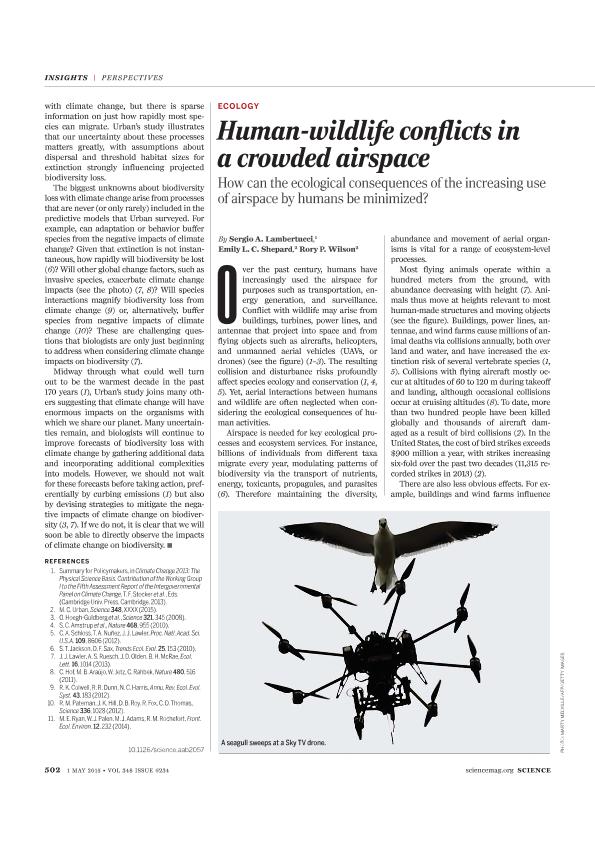Mostrar el registro sencillo del ítem
dc.contributor.author
Lambertucci, Sergio Agustin

dc.contributor.author
Shepard, Emily L. C.
dc.contributor.author
Wilson, Rory P.
dc.date.available
2017-01-31T19:24:22Z
dc.date.issued
2015-05-01
dc.identifier.citation
Lambertucci, Sergio Agustin; Shepard, Emily L. C.; Wilson, Rory P.; Human-wildlife conflicts in a crowded airspace: how can the ecological consequences of the increasing use of airspace by humans be minimized?; American Association For The Advancement Of Science; Science; 348; 6234; 1-5-2015; 502-504
dc.identifier.issn
0036-8075
dc.identifier.uri
http://hdl.handle.net/11336/12259
dc.description.abstract
Over the past century, humans have increasingly used the airspace for purposes such as transportation, energy generation, and surveillance. Conflict with wildlife may arise from buildings, turbines, power lines, and antennae that project into space and from flying objects such as aircrafts, helicopters, and unmanned aerial vehicles (UAVs, or drones) (see the figure) (1–3). The resulting collision and disturbance risks profoundly affect species ecology and conservation (1, 4, 5). Yet, aerial interactions between humans and wildlife are often neglected when considering the ecological consequences of human activities.
dc.format
application/pdf
dc.language.iso
eng
dc.publisher
American Association For The Advancement Of Science

dc.rights
info:eu-repo/semantics/openAccess
dc.rights.uri
https://creativecommons.org/licenses/by-nc-sa/2.5/ar/
dc.subject
Airspace
dc.subject
Conservation
dc.subject
Flying Species
dc.subject
Human-Wildlife Conflict
dc.subject.classification
Conservación de la Biodiversidad

dc.subject.classification
Ciencias Biológicas

dc.subject.classification
CIENCIAS NATURALES Y EXACTAS

dc.title
Human-wildlife conflicts in a crowded airspace: how can the ecological consequences of the increasing use of airspace by humans be minimized?
dc.type
info:eu-repo/semantics/article
dc.type
info:ar-repo/semantics/artículo
dc.type
info:eu-repo/semantics/publishedVersion
dc.date.updated
2016-12-12T14:22:29Z
dc.identifier.eissn
1095-9203
dc.journal.volume
348
dc.journal.number
6234
dc.journal.pagination
502-504
dc.journal.pais
Estados Unidos

dc.description.fil
Fil: Lambertucci, Sergio Agustin. Universidad Nacional del Comahue. Centro Regional Universitario Bariloche. Laboratorio de Ecotono; Argentina. Consejo Nacional de Investigaciones Científicas y Técnicas. Centro Científico Tecnológico Patagonia Norte. Instituto de Investigación en Biodiversidad y Medioambiente; Argentina
dc.description.fil
Fil: Shepard, Emily L. C.. Swansea University; Reino Unido
dc.description.fil
Fil: Wilson, Rory P.. Swansea University; Reino Unido
dc.journal.title
Science

dc.relation.alternativeid
info:eu-repo/semantics/altIdentifier/doi/http://dx.doi.org/10.1126/science.aaa6743
dc.relation.alternativeid
info:eu-repo/semantics/altIdentifier/url/http://science.sciencemag.org/content/348/6234/502
Archivos asociados
